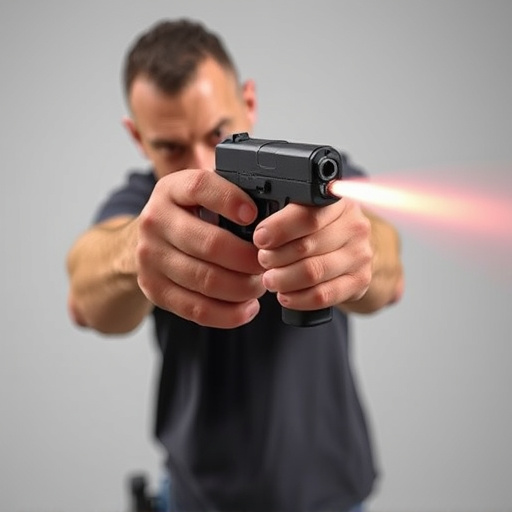Proper storage and adherence to guidelines are essential for maintaining pepper spray's effectiveness and extending its 3-5 year shelf life. Store it in cool, dry places like locked cabinets, avoiding direct sunlight and extreme temperatures. Keep containers sealed, labeled with expiration dates, and inspect regularly for damage or changes in consistency. Following these practices optimizes the performance of your personal defense tool.
“Uncover the power of pepper spray as a personal defense mechanism with our comprehensive guide. We demystify its operation, exploring how this non-lethal deterrent disables aggressors through targeted irritation. This article delves into crucial aspects of storage and maintenance, revealing key factors for optimal effectiveness and extended shelf life. Learn best practices to ensure your pepper spray remains reliable when you need it most, empowering you with vital knowledge for maximum personal protection.”
- Understanding Pepper Spray: The Basics of its Operation as a Deterrent
- Storage Considerations for Optimal Effectiveness and Shelf Life
- Factors Affecting Pepper Spray's Lifespan: What You Need to Know
- Best Practices for Maintaining and Using Your Pepper Spray for Maximum Protection
Understanding Pepper Spray: The Basics of its Operation as a Deterrent
Pepper spray is a popular personal defense tool designed to disable an attacker temporarily, providing users with an opportunity to escape or seek help. Its primary active ingredient is capsaicin, the compound responsible for the heat and pain sensation in chili peppers. When sprayed, capsaicin irritates the eyes, nose, throat, and skin, causing the target to experience a burning sensation and reduced visibility. This disruption in balance and discomfort encourages the attacker to retreat, thus acting as an effective deterrent.
Proper storage and understanding of pepper spray’s shelf life are essential components of its effectiveness as a defense mechanism. Most modern pepper sprays come with specific instructions for optimal performance, including recommended storage conditions and expiration dates. Factors like temperature, humidity, and light exposure can impact the spray’s potency and longevity. Following manufacturer guidelines ensures that the spray remains potent when needed, making it a reliable deterrent against potential threats.
Storage Considerations for Optimal Effectiveness and Shelf Life
Proper storage is crucial for maintaining pepper spray’s optimal effectiveness and extending its shelf life. Store it in a cool, dry place away from direct sunlight or extreme temperatures. Ideal locations include locked cabinets or secure areas with consistent humidity levels. Avoid leaving it in your vehicle, as fluctuating temperatures can compromise its potency. Keep the container intact and sealed to prevent contamination; avoid exposing it to moisture or other chemicals that might weaken its formula.
For best results, label the spray clearly with its expiration date or lot number. Most pepper sprays have a shelf life of 3 to 5 years when stored correctly, but active ingredients can degrade over time. Regularly inspect the spray for any signs of damage or changes in consistency; discard it if it shows any abnormalities. Following these storage considerations ensures that you have a reliable deterrent available when needed.
Factors Affecting Pepper Spray's Lifespan: What You Need to Know
Pepper spray, a popular personal defense mechanism, has a lifespan influenced by various factors. One key aspect is storage conditions. Extreme temperatures, both hot and cold, can degrade the spray’s potency over time. It’s recommended to keep pepper spray in an area with consistent room temperature, away from direct sunlight or heat sources. Humidity also plays a role; high humidity levels can affect the spray’s consistency and effectiveness.
Additionally, proper pepper spray storage and shelf life practices are essential. After each use, ensure the canister is properly sealed to prevent evaporation. Store it in a secure location, out of reach of children or unauthorized individuals. While most pepper sprays have a shelf life of around 2-3 years, regular testing is advised to ensure its continued viability. Following these guidelines can maximize the effectiveness and lifespan of your pepper spray deterrent.
Best Practices for Maintaining and Using Your Pepper Spray for Maximum Protection
To ensure maximum protection, proper maintenance and understanding of your pepper spray is crucial. Start by storing it in a cool, dry place, away from direct sunlight or extreme temperatures. Keep it out of reach of children and unauthorized individuals; a locked safe or high shelf can be ideal. Regularly inspect the spray for any signs of damage or leakage, discarding it if necessary. Check the expiration date and replace it before its shelf life expires, as pepper spray potency diminishes over time.
When using your pepper spray, follow the manufacturer’s instructions precisely. Practice your technique regularly to ensure you can deploy it quickly and accurately in an emergency situation. Store extra canisters nearby for easy access during practice sessions, allowing you to familiarize yourself with the device while also maintaining a charged defense mechanism.
Pepper spray, as a powerful personal defense mechanism, can provide crucial protection when used properly. To ensure its optimal effectiveness and longevity, understanding and implementing best practices for storage and maintenance is essential. By considering factors such as temperature, humidity, and proper containment, you can maximize the shelf life of your pepper spray, ensuring it remains a reliable deterrent against potential threats. Remember, proper storage and regular upkeep are key to leveraging this game-changer in personal safety.
